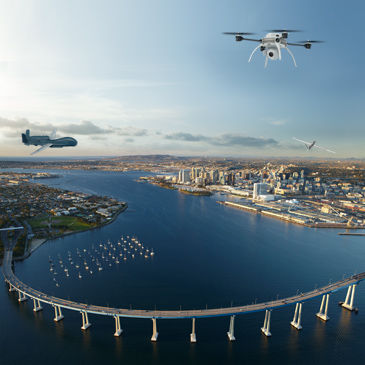
Drones over San Diego
photo illustration by priddy smith |aerial Photo by Phillip Colla

General Atomics Predator

Datron Scout

Northrop Global Hawk

Northrop Fire Scout
Drone production is big business in San Diego. After national budget cuts, the industry stands to take a financial hit. But a pending application for private drone use could make the county the center for commercial development for decades to come.
Domino’s Pizza saw the future of drones. In a YouTube video shot outside London, a Domino’s employee loads a pizza into a warming bag, which in turn is gripped by a small helicopter, roughly 3 feet in diameter and powered by six small rotors. The Domino’s employee, holding a tablet computer, orders the “Domicoptor” into the sky. A camera follows the now-airborne pizza over field and stream until it descends outside a suburban home. A gray-shirted man removes the pizza from the bag and walks back to his house, and the helicopter pulls away, ready for another delivery.
The ad is a vision of a civilian, commercial drone economy that doesn’t yet exist. In this country, the Federal Aviation Association (FAA) bans all commercial flights of unmanned aerial vehicles, or UAVs. So far, that’s fine for San Diego County, center of the universe for the military drone industry and home to General Atomics Aeronautical Systems, and Northrop Grumman, both leaders in military drone production.
Even as wars in Iraq and Afghanistan wind down and budget squabbles in Washington force military cuts, local observers say funds for advanced military technology like UAVs should be safe—but they aren’t. The latest proposal from the Pentagon calls for deep cuts in purchases from both companies.
If San Diego wishes to keep its leadership in the drone industry, it will need the civilian market to make up for lost energy and money in military drones. That may depend on whether the county wins the right to become one of six drone testing areas proposed by the FAA. The application should be a shoo-in, but public concerns over privacy and a lack of local political support lengthen the odds against the region’s submission.
The first unmanned flying vehicles date back to the Civil War, when, in 1863, inventor Charles Perrey patented a device that used a timer to drop explosives on enemy troops, according to an article on Legal.com penned by San Diego lawyer and pilot David Cain. The device didn’t work, though both Confederate and Union troops tried it. Technology progressed slowly, from kites bearing cameras in 1898 to an explosive-laden biplane in World War I. Not until World War II did something resembling a modern drone appear, in the form of an automated propeller-driven aircraft used as target practice for anti-aircraft exercises.
The story moves to San Diego in 1947, when the Navy contracted aircraft manufacturer Ryan Aeronautical to build remote-controlled jet-drones for target practice. In 1968, Teledyne purchased Ryan Aircraft, forming Teledyne-Ryan, a force in UAV manufacture for the next three decades.
In the 1980s, the Israelis invented the first autonomous drone.
“Those early ones were based entirely on remote-control aircraft technology and mated with closed-circuit TVs,” says Ben Kristy, aviation curator of the National Museum of the Marine Corps in Virginia.
The Marines used the Israeli model as the basis for the RQ-2 Pioneer, a drone that could be launched from a ship-based catapult and sent out to take pictures of enemy lines. The Pioneer saw action through 2007, including a highlight in 1991 when a squad of Iraqis surrendered to one during the Gulf War.
In 1992, General Atomics formed General Atomics Aeronautical Systems in Poway, and began development of its signature Predator drone, which it flew successfully in 1994.
In 1999, Northrop Grumman, also in the drone business (Marilyn Monroe was discovered working a Northrop production line by an Army photographer shooting publicity photos on assignment from Ronald Reagan, at a factory in the 1940s), purchased Teledyne-Ryan, absorbing hundreds of experienced San Diego staff. In March, the company consolidated UAV design units from New York and Arizona into its Rancho Bernardo UAV Center for Excellence.
Together, the two companies are a powerful economic force in the region. According to a study from the National University System Institute for Policy Research, the two companies provided 7,135 direct and indirect jobs in San Diego County in 2011, and managed $1.28 billion in UAV contracts. Combined, they produce about 60 percent of all UAVs in the world.
With these two behemoths in town, other companies have found ways to draw income in the same business. SciFly in Kearny Mesa creates computer models to test drone designs, and Core Systems in Poway builds rugged computers for the aircraft.
“It makes sense that companies in the same industry with the same interests would be close by each other,” says Mike Rigney, a board member for the Association for Unmanned Vehicle Systems International, San Diego-Lindbergh Chapter.
These companies, largely high-tech and boasting high-salaried, highly skilled employees, joined the rest of the defense manufacturing industry to insulate San Diego County from the worst of the Great Recession and the sluggish recovery of the last five years.
Drones make the military’s job easier—that’s why they have been such a growth industry. Squads use small UAVs in Iraq and Afghanistan to scout enemy lines and look around corners or into caves. Large drones carry complicated instrument packages that let them detect heat signatures and intercept communications. A General Atomics Predator or a Global Hawk from Northrop Grumman can stay aloft for 30 hours, and a Northrop Grumman Fire Scout helicopter can stay up for 12 hours (compared to four or five for a manned plane), sending back live video streams to operators thousands of miles away.
Also, with no pilot onboard, a downed UAV is less likely to need a search and rescue mission.
“Unmanned systems can do the dull, the dirty, and the dangerous,” says Mike Fuqua, a retired Navy helicopter pilot and director of business development for the Fire Scout at Northrop Grumman. “There were plenty of times I was flying around the ocean looking for things. A [UAV] can do those kinds of missions that you just don’t need a person there to do. The Fire Scout is cheaper to acquire and cheaper to operate than any manned platform.”
But there are problems, too. The cost of each Global Hawk has ballooned to $200 million. It carries a smaller payload than the U-2 spy aircraft it’s supposed to replace. The U-2 also flies 15,000 feet higher than a Global Hawk, giving it a greater horizon for surveillance. Development problems with the Gray Eagle, an Army version of General Atomics’ Predator, have led to delays in deployment.
These issues, the impact of half a trillion dollars in military cuts as part of the budgetary gimmick known as “sequestration,” and the intended reduction in spending after the wars in Iraq and Afghanistan end mean the military is primed to slash spending on UAVs.
The military is dropping its funding of Gray Eagle and Global Hawk by 16 percent to $869 million in 2013, and then by another 24 percent in 2014. Last year, the Air Force asked to mothball all 18 of the Global Hawks it had in its fleet in favor of the U-2 planes. The Air Force also plans to cut its annual purchase of General Atomics Reapers—armed versions of the Predator—from 48 two years ago to 24 this year, and then to 12 next year.
(A Pentagon spokesman did not respond to our request for an interview on the budget decisions.)
By contrast, the Navy is very excited about the drones it has in the offing. The X-47B, under development by Northrop Grumman, just successfully took off and landed from an aircraft carrier for the first time—a major technical achievement—and development is full speed ahead for the Triton, a customized Global Hawk made to handle the conditions of high-altitude surveillance over the ocean. The Navy also plans to keep purchasing Fire Scouts.
Congress could end up rewriting all these budget plans when it comes to appropriations, but the possibility of reductions bodes ill for San Diego’s future—unless private commercial UAVs, many of which use the same technology as the military drones, can grow to fill the economic niche. To do that, UAV manufacturers will have to allay the public’s fears about privacy and the use of armed drones to kill American citizens.
Domino’s shot its drone commercial in the UK for a reason: the FAA grounds commercial drones in the U.S., with the exception of a few universities and public agencies. But that doesn’t mean some companies and agencies haven’t found ways to use unmanned flyers in their work. During the wildfires that ravaged San Diego County in 2007, CalFire asked the Air Force to scramble a Northrop Grumman Global Hawk to look for hot spots and help track the fires. The Border Patrol is using UAVs to patrol the boundary with Mexico. A NASA-owned Global Hawk tracked a storm off the Mexican coast in 2010, according to U-T San Diego.
Last year, the FAA had to shut down a Los Angeles realtor who used a UAV to take aerial pictures at low cost. David Cain, the lawyer and UAV historian, expects FedEx and UPS will use pilot-optional aircraft to reduce the cost of flying freight (spokesmen from both companies say there are no such plans). Small drones could be put to work doing pipeline inspections, or scanning farms for pests or weed invasions. Cain believes the technology used in military drones will find its way into a private commercial market, much as the Internet and GPS technology did.
Cain says, “We have never not brought home wartime technology for commercial benefit.”
Small drones are easy to use and cheap to run. Datron World Communications in Vista produces the Scout helicopter in partnership with a Canadian firm. A Scout weighs less than four pounds. It’s designed for use by foreign militaries and public safety agencies, so it can handle high winds and rain. Its parts can be snapped on and off, so if one malfunctions, it can be easily replaced. The device runs on electricity, and charging it up is cheaper than filling a helicopter with aviation fuel. And it’s inexpensive to own: a no-frills Scout costs $60,000 to purchase, says Chris Burk, Scout program director for Datron.
“About as much as a police squad car,” he adds.
Much to the surprise of anyone raised on footage of Maverick wrestling the control stick of his F-14 high above the San Diego desert, flying a Scout is remarkably simple. Instead of months and years of training (or attending Top Gun flight school), anyone can learn to fly a Scout, with a three-day training class. The computer handles most of the hard stuff (as is the case for Predator and Global Hawk, though military operator training is more intense). The Scout can be flown from a tablet computer, or allowed to roam on a pre-programmed flight pattern for up to 30 hours. It can take off and land on its own, too, so theoretically—although Burk strongly advises against this—a Scout operator could let it take off, go out for lunch, and run some errands, and the Scout will do business on its own.
That kind of operation may be easy to perform within a few years. Under the FAA Modernization and Reform Act of 2012, Congress ordered the FAA to develop rules for small UAVs, defined as those under 55 pounds, and to find a way to integrate larger UAVs into the national air space by 2015.
The agency expects to develop rules for small UAVs—like the Domicoptor—by the end of this year. They should be published by 2015, after public comment and rules revisions, according to Jim Williams, head of the FAA’s Unmanned Aircraft Systems Integration Office.
Larger UAVs face more sophisticated hurdles, particularly the ability to automatically detect and avoid each other, and some legal framework for UAV liability in the civilian airspace.
In order to gather data on just how the UAVs will work with piloted craft, the agency will name six regions around the country and give them permission to fly UAVs in their airspace. The program comes with no federal money, and the designation requires creating a research plan and collecting data on behalf of the FAA. Williams says 25 regions in 24 states applied (including a delegation from Ventura County in California).
“It would be very valuable from the standpoint of the operators to create jobs and prime the pump on the industry,” Williams said at a conference in Washington, D.C.
California stands to gain more from this commercial revolution than any other state, according to a study by the Association for Unmanned Vehicle Systems International (AUVSI). If the state wins one of the test-bed applications, it can expect total UAV jobs in the state to double by 2021, to 15,000, and for the economic impact to reach $1.7 billion by 2025.
San Diego’s application includes businesses and associations located in a wide swath of Southern California, from the Mexican border to Naval Air Weapons Station China Lake, 100 miles east of Bakersfield. Much of the driving energy comes from the San Diego Military Advisory Council (SDMAC), the San Diego Regional Economic Development Corporation (EDC), and the Indian Wells Airport District. Its business participants include a variety of companies, including General Atomics (but not Northrop Grumman, which said through a spokesman that it’s monitoring the situation closely).
“We see it (the UAV industry) as really being a huge economic driver for our region,” says Matt Sanford, a manager at the San Diego Regional EDC. “We think the growth potential is there. We have the talent and workforce to keep advancing and keep innovating in that space.”
With its base of UAV workers and companies, San Diego would seem to be a slam-dunk, but supporters are nervous, due to a lack of vocal support from the local Congressional delegation and privacy protection laws working their way through the state legislature.
While North Dakota, New York, Florida, and Texas all have full-throated backing and, in some cases, financial backing from their governors, legislatures, and representatives in Washington, most of California’s representatives have been silent on the subject. (The lone exception is Rep. Kevin McCarthy, the House Majority Whip, who represents Bakersfield.) Local politicians didn’t exactly line up, either.
“We went to San Diego County; they weren’t interested. The Airport (Authority) was kind of interested,” says Terry Magee, with SDMAC.
None of the legislators contacted for this story, nor Gov. Jerry Brown, responded to requests for comment. One Congressional staffer said on background that legislators worry about the problems of privacy inherent in the use of UAVs.
Privacy and safety are on everyone’s mind recently. In June, now-fugitive National Security Administration contractor Edward Snowden revealed that the federal government was collecting phone data from Verizon and had backdoor access to all the data from major Internet sites like Facebook, Gmail, and Yahoo.
Fears of weaponized drones compound public concerns. Drones have been weaponized for years for use overseas against America’s enemies, but in May, Attorney General Eric Holder revealed that four Americans had been killed in drone attacks. The announcement came on the heels of Sen. Rand Paul’s 13-hour filibuster to demand that the Obama administration promise not to kill citizens on American soil.
This is not a time when the American people want to grant their security agencies unfettered access to small, inexpensive devices that can spy—or possibly kill—from a great height.
While the Obama administration has promised not to kill “non-combatants” (as defined by the administration), the FAA itself has decided to tackle the privacy issue. As part of the application for test sites, applicants must explain how they’ll safeguard privacy.
In California, the American Civil Liberties Union leads the charge for getting privacy protection written into law.
“Drones are like any new technology; they can be used for good or for ill,” says David Loy, legal director for the San Diego chapter of the ACLU. “Because they are so potentially intrusive, we need checks and balances to make sure privacy isn’t abused, that it’s a respected, transparent system for collection and storage of data.”
According to Loy and Valerie Small Navarro, a Sacramento-based legislative analyst for the California chapter, the ACLU wants to require law enforcement to get a warrant from a judge before using a UAV for an investigation, and it wants all data collected to be destroyed after 60 days.
The group also worries about the sharing of data among government agencies.
“We don’t want to use this technology to let us live in a permanent surveillance state,” Loy says.
A pair of competing bills is working through the California legislature implementing some of the ACLU’s recommendations. Both place substantial restrictions on the use of UAVs by private parties—criminalizing some actions—and by government agencies, especially police departments.
The ACLU’s bills may be contributing to an image that San Diego is not a hospitable place for a FAA testing site.
“We haven’t verified this, but we’re told by those people that are watching the process that there could be negative impact, if you’re from a state that’s passed anti-[UAV] legislation,” says Eileen Shibley, a defense department consultant and the woman leading the FAA bid for Southern California.
The FAA will choose the six sites by the end of the year.
In the meantime, San Diego will wait tensely. And if indeed the last pilot has already been born, many San Diegans hope the reason for that will begin right here.
















